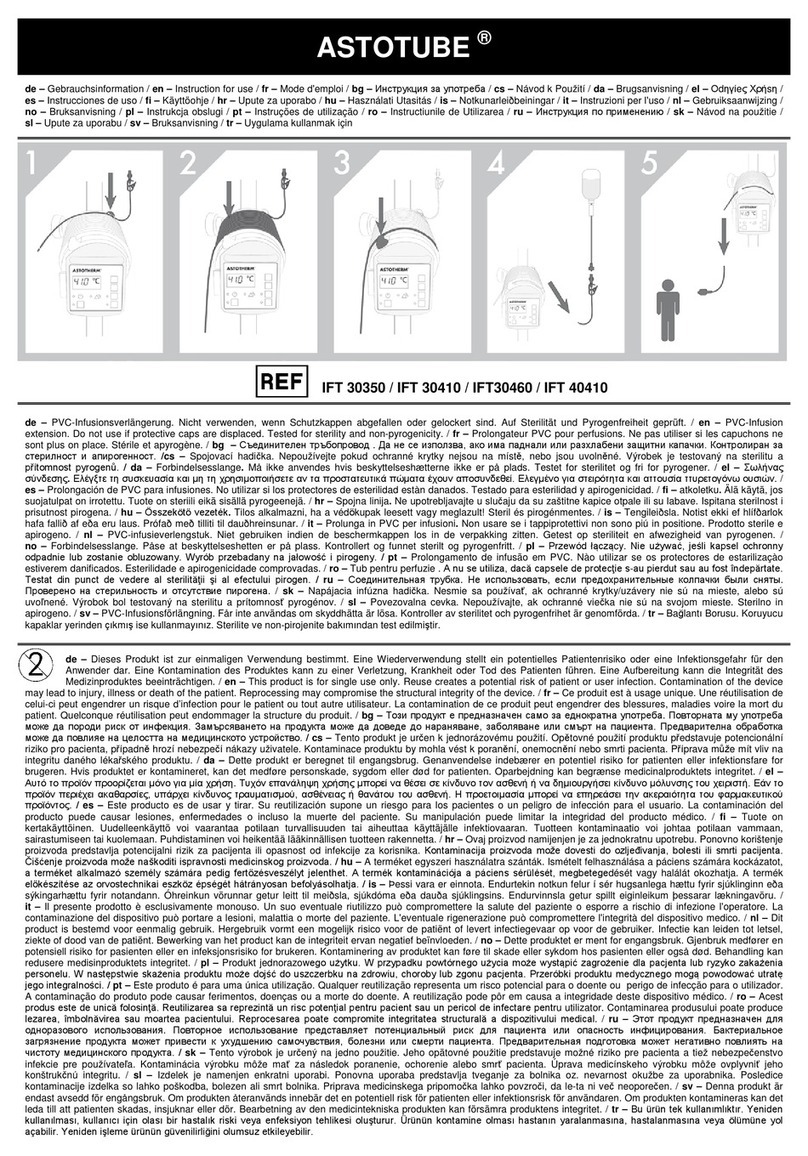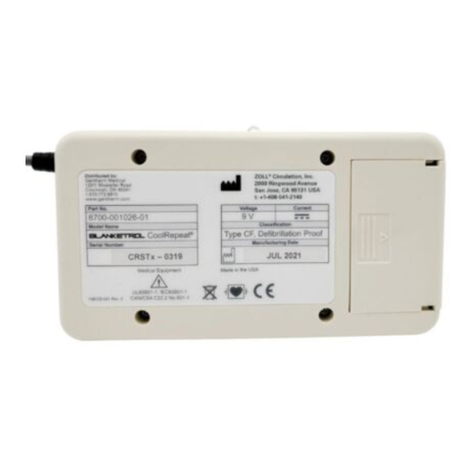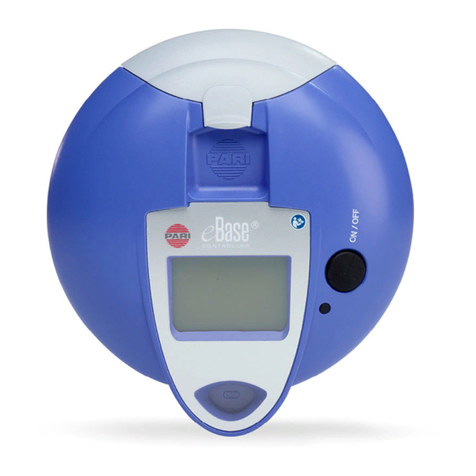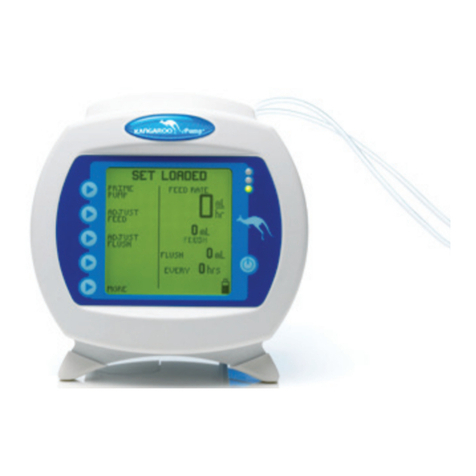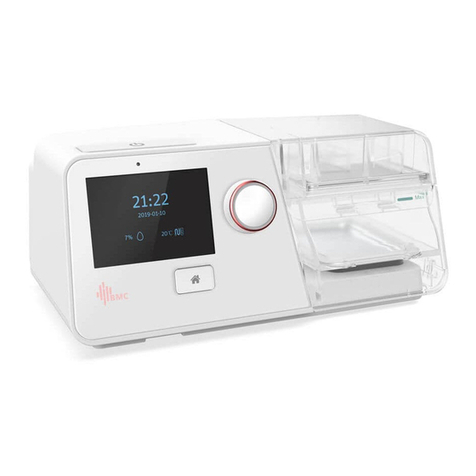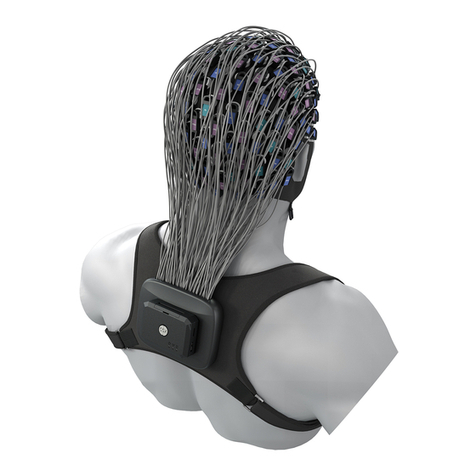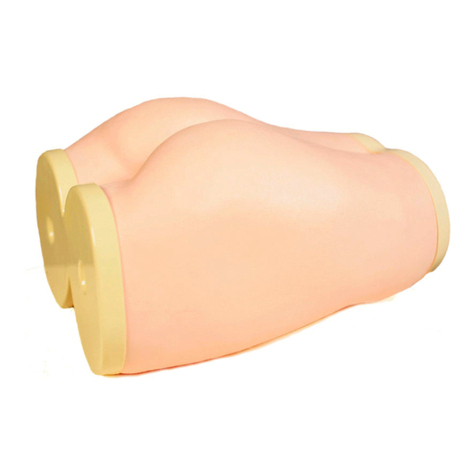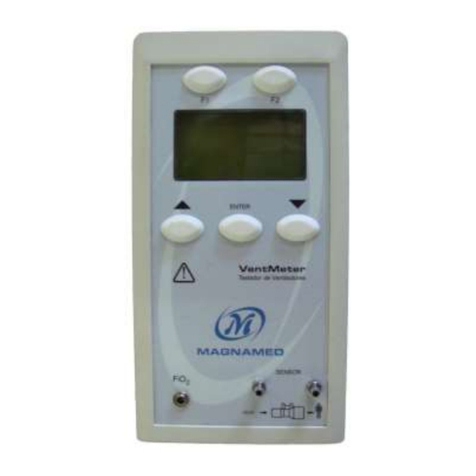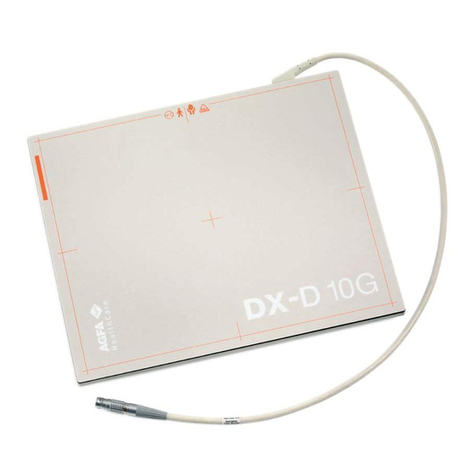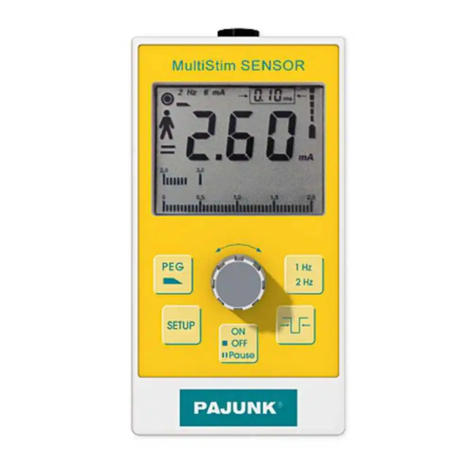Gentherm STIHLER ELECTRONIC ASTODIA DIA100 User manual

Instructions for Use
ASTODIA®
Diaphanoscope
DIA100
DIA120
DIA130
DIA140
STIHLER ELECTRONIC GmbH •70771 Leinfelden - Echterdingen •Germany
Part no. 0811.7200.12 Rev. 09 05/2021

To be completed by the user:
Serial number
Registration number
Equipment location
Start-up date
Manufacturer:
STIHLER ELECTRONIC GmbH
Gaussstrasse 4
70771 Leinfelden - Echterdingen
GERMANY
Tel. +49 (0) 711-720670
Fax +49 (0) 711-7206757
www.stihlerelectronic.de
E-Mail: info@stihlerelectronic.de
© 2021 STIHLER ELECTRONIC GmbH
STIHLER ELECTRONIC GmbH, Leinfelden - Echterdingen, declares in sole
responsibility that this product conforms to the regulation (EU) 2017/745 on
medical devices (MDR).

Contents
1 Introduction .....................................................................................................................4
1.1 INFORMATION ON THESE INSTRUCTIONS ............................................................................4
1.2 INTENDED USE................................................................................................................4
1.2.1 Intended medical indications.............................................................................................4
1.2.2 Contraindications..............................................................................................................4
1.2.3 Possible adverse effects...................................................................................................4
1.2.4 Intended patient group......................................................................................................4
1.2.5 Intended body part............................................................................................................4
1.2.6 Intended user profile.........................................................................................................4
1.2.7 Intended environment of use / operation...........................................................................5
1.3 IMPORTANT SAFETY INFORMATION ....................................................................................6
1.3.1 Dangers............................................................................................................................7
1.3.2 Warnings..........................................................................................................................7
1.3.3 Caution information ..........................................................................................................9
1.3.4 Notices...........................................................................................................................10
1.4 SYMBOLS.....................................................................................................................11
1.5 CONFORMITY WITH INTERNATIONAL STANDARDS...............................................................12
1.6 GUARANTEE CONDITIONS...............................................................................................12
1.7 LIABILITY......................................................................................................................13
1.8 DISPOSAL OF THE EQUIPMENT........................................................................................13
1.9 INFORMATION ON BATTERY DISPOSAL..............................................................................13
1.10 RETURN OF A USED PRODUCT ......................................................................................14
1.11 SERVICE INFORMATION................................................................................................14
1.12 INCIDENT REPORTING ..................................................................................................14
2 Product description.......................................................................................................15
2.1 INTRODUCTION .............................................................................................................15
2.2 TECHNICAL DESCRIPTION ..............................................................................................15
2.3 COMPONENTS OF ASTODIA.........................................................................................16
3 Installation .....................................................................................................................17
3.1 INITIAL START-UP ..........................................................................................................17
4 Start-up...........................................................................................................................17
4.1 PREPARATION FOR USE .................................................................................................17
4.2 STARTING ....................................................................................................................17
4.3 END OPERATION ...........................................................................................................18
4.4 CHARGING THE BATTERIES.............................................................................................18
4.5 CLEANING AND DISINFECTING.........................................................................................19
5 Troubleshooting............................................................................................................20
DEVICE CANNOT BE STARTED...............................................................................................20
BATTERIES CANNOT BE CHARGED.........................................................................................20
6 Servicing........................................................................................................................21
6.1 PREVENTATIVE SERVICING.............................................................................................21
6.2 PERIODIC SAFETY INSPECTION.......................................................................................21
6.2.1 Visual inspection ............................................................................................................21
6.2.2 Check the function of the yellow and the red LED...........................................................21
6.2.3 Check the functioning of the reduction of the maximum light intensity and the automatic
switching off ............................................................................................................................22
6.2.4 Electrical Test.................................................................................................................22
7 Technical data ...............................................................................................................23
8 Ordering information.....................................................................................................24
9 Guidelines and manufacturer’s declaration................................................................25

ASTODIA Instructions for Use
1 Introduction
4
1 Introduction
1.1 Information on these instructions
It is imperative that you read these instructions for use before us-
ing this product. Failure to follow the instructions for use can re-
sult in damage to the product or to other property and/or personal
injury.
These instructions contain important information on the safe use of
ASTODIA.
Fully read the instructions for use, including the warning and caution information,
before you use ASTODIA. Failure to follow the warnings, cautions, and infor-
mation on use can result in death or severe injury to the patient.
ASTODIA consists of a control unit DIA120, a hand piece DIA130 and a
charger DIA140.
These instructions for use are directed towards trained healthcare personnel and
persons in medical professions.
1.2 Intended use
The Diaphanoscope ASTODIA serves for searching blood vessels and helps
identify structures filled with air or fluid deep under the skin surface.
1.2.1 Intended medical indications
It serves for the transillumination of the biological tissue, to visualize its structures;
e.g. in the overextented, neonatal wrist joint of the dorsopalmar, to punctuate the
radial and ulnar arteries while they are visible and for the quick identification of a
pneumothorax or a hydrocele in the field of paediatrics/neonatology.
1.2.2 Contraindications
Contraindications for the transillumination of tissue using visible light are not
known for the intended use.
1.2.3 Possible adverse effects
In normal use, no adverse effects arising from ASTODIA are to be expected.
1.2.4 Intended patient group
Paediatrics and preferably for premature babies and neonates.
1.2.5 Intended body part
Contact with intact skin, torso and extremities on all sides.
1.2.6 Intended user profile
Medical staff (e.g., doctor, nurse, nurse, service personnel, medical technician).

1 Introduction
ASTODIA Instructions for Use
5
1.2.7 Intended environment of use / operation
•ASTODIA may only be used in professional healthcare facilities (e.g. hospital,
emergency care, dialysis, etc.).
•ASTODIA is not intended for home healthcare environment and for veterinary
medicine.
•ASTODIA is reusable, but requires cleaning / disinfection between the applica-
tions.
•Appropriate medical hygienic factors must be applied for the use of ASTODIA.
•ASTODIA must not be used in an environment at risk of explosion or in the
present of flammable anesthetics.

ASTODIA Instructions for Use
1 Introduction
6
1.3 Important safety information
These instructions for use define and refer to the following safety information.
DANGER
Describes a maximum risk from a situation which, when not avoided, can lead
directly to severe or fatal injuries.
WARNING
Describes a dangerous situation which, when not avoided, can lead to severe
or fatal injuries.
CAUTION
Describes a dangerous situation which, when not avoided, can lead to mild to
moderate injuries.
NOTICE
Indicates information considered important, but that does not relate to risks (e.g.
reference to property damage).

1 Introduction
ASTODIA Instructions for Use
7
1.3.1 Dangers
DANGER
Explosion hazard!
Do not use the ASTODIA diaphanoscope in an explosion-hazard environment
or in the presence of flammable anaesthetics.
1.3.2 Warnings
WARNING
Risk of injury!
•Read and observe all instructions, stickers, and accompanying documenta-
tion that came with the medical device. Failure to observe the instructions,
including warnings and safety information, can result in incorrect handling,
patient injury, user injury, medical personnel injury, damage to the device, or
material damage.
•Operate and service this equipment only in accordance with the procedures
described in these instructions and with the applicable standards, rules, and
guidelines. The manufacturer shall not be responsible for the safety of users
or patients if any actions/procedures other than those published are carried
out during operation, servicing, or repeated inspections.
•Operating and servicing personnel must be appropriately trained and medi-
cally qualified.
•ASTODIA does not contain any parts the user can repair. Therefore, do not
attempt to repair ASTODIA yourself. Contact your local sales point.
•Do not use ASTODIA until the following error conditions have been remedied
through appropriate corrective action:
- Damaged or worn cables, plugs, or device box.
- Damaged casing, damaged or loose control panel.
- A system that has been exposed to mechanical impact or liquid ingress
into internal electronic system components
•Only persons authorised and qualified by the manufacturer may perform re-
pairs to the equipment.
•To prevent the risk of an electric shock, strictly use a charger approved by the
manufacturer.
•Modifications to ASTODIA are not permitted.
WARNING
Risk of infection!
Clean and disinfect the equipment after every use and before you return the
equipment for repairs.

ASTODIA Instructions for Use
1 Introduction
8
WARNING
Risk of electric shock!
•All electrical installations must conform to the applicable electrical standards
and the specifications defined by the manufacturer.
•During charging, the device shall not be in the patient environment.
WARNING
Risk of radio interference!
•Use of this equipment adjacent to or stacked with other equipment should be
avoided because it could result in improper operation. If such use is necessary,
this equipment and the other equipment should be observed to verify that they
are operating normally.
•Use of accessories, other than those specified or provided by the manufacturer of
this equipment could result in increased electromagnetic emissions or decreased
electromagnetic immunity of this equipment and result in improper operation.
•Portable RF communications equipment (including peripherals such as antenna
cables and external antennas) should not be used at a distance less than 30 cm
(12 inches) to any part, including cables of the device specified by the manufac-
turer. Otherwise, degradation of the performance of this equipment could result.

1 Introduction
ASTODIA Instructions for Use
9
1.3.3 Caution information
CAUTION
Risk of injury!
•The use of the ASTODIA diaphanoscope must be carried out under the re-
sponsibility of a physician.
•In case ASTODIA starts directly after switch on in the highest light level and a
change of the highest level is not possible - then do not use ASTODIA!
•Due to its high light intensity this device may not be used in close vicinity to
the patient's eyes.
•If the ASTODIA control unit is being charged, a safety distance of at least
1.5 m has to be kept.
•In case of continuous use at maximum intensity to a fixed point on the sur-
face of the skin, temperatures of up to 48 ºC can be reached within a period
≤ 2 minutes even when device is being used in the intended use.
Due to the small surface area and short amount of time, this should not be
classed as a critical issue (see IEC/EN 60601-1).
The slight redness that can be seen after use is quickly reversible and does
not cause tissue lesions.
•ASTODIA may not be used several times on a fixed point on the surface of
the skin.
•Once ASTODIA has been switched on, the red and yellow LEDs of the hand
piece each flash three times (functional testing). ASTODIA may only be used
after the LEDs have flashed. If the LEDs do not flash as described, ASTODIA
must be serviced before being used again.
CAUTION
Risk of radio interference!
•According to Standard IEC/EN 60601-1-2, medical electrical equipment re-
quires special precautionary measures in regard to electromagnetic compati-
bility (EMC). Install and operate medical equipment according to the EMC in-
formation listed in the accompanying documentation. Portable and mobile RF
communication equipment may have an impact on medical electrical equip-
ment.
•This equipment/system can produce radio interference and can interfere with
the operation of equipment in close proximity. It may be necessary to take
appropriate corrective action, such as a new direction, a new configuration of
ASTODIA, or shielding.
•The essential performance can be lost or degraded due to EM disturbances.

ASTODIA Instructions for Use
1 Introduction
10
1.3.4 Notices
NOTICE
•Actions to avoid damaging the diaphanoscope:
- Do not immerse the control unit and/or the connector for the connection ca-
ble in liquid.
- Do not disinfect the system using steam (e.g., in autoclaves), hot air, or
thermo-chemical cleaning solutions.
•The customer is responsible for the proper packaging and labelling of returns.
•The operator should not use any cleaning or decontamination methods other
than those recommended by the manufacturer.

1 Introduction
ASTODIA Instructions for Use
11
1.4 Symbols
Symbols and indications on the control panel
Switch key for LED-colours - press shortly
OFF button - press and hold (ca. 1 s)
ON button
Reduce the light intensity
ON button
Increase the light intensity
Where applicable, these symbols appear at the appropriate location on the
patient warming system, on the packaging, on the identification plate, or in the
accompanying documentation.
This symbol states that this device is a Type BF applied part to
standards IEC/EN 60601-1 and VDE 0750 Part 1.
IPX 0
This symbol indicates following IEC/EN 60529 that this device
does not have specific protection against humidity.
Observe the instructions for use.
General warning/danger symbol
Reference (part) number
Lot number
Serial number
Year of manufacture
Manufacturer
Distributor
This symbol on the control unit indicates that this device complies
with the requirements of the regulation (EU) 2017/745 on medical
devices (MDR).
Warning of optical radiation. Do not aim LED directly at the eyes!
Electrical devices are recoverable waste and should not be dis-
posed of in domestic waste at the end of their service life.

ASTODIA Instructions for Use
1 Introduction
12
Batteries and rechargeable batteries are recoverable waste and
should not be disposed of in domestic waste at the end of their
service life.
General recycling symbol
Additional information
Symbol for the permitted temperature range for storage and
transport
Symbol for the permitted moisture range for storage and transport
Symbol for the permitted atmospheric pressure range for storage
and transport
Transport with the arrows pointing up
Keep dry
Fragile, protect against impacts
Medical Device
1.5 Conformity with international standards
Standard
Title
IEC/EN 60601-1
Medical electrical equipment – Part 1: General require-
ments for basic safety and essential performance
IEC/EN 60601-1-2
Medical electrical equipment – Part 1-2: General re-
quirements for basic safety and
essential performance – Collateral standard: Electro-
magnetic compatibility – Requirements and tests
1.6 Guarantee conditions
The guarantee period is 12 months. During this guarantee period the manufactur-
er will repair or replace free of charge all defects caused as a result of material or
manufacturing errors.
Other damage is not subject to this guarantee. The guarantee does not include
cases of misuse or incorrect handling, use of force, or damage caused by normal
wear and tear. This applies also to changes undertaken by persons who are not
authorised by the manufacturer and to modifications to the original condition.
If the equipment is damaged during the guarantee period, send the cleaned
equipment to the nearest sales point or directly to STIHLER ELECTRONIC
GmbH. The sender is responsible for any transport and packaging costs.

1 Introduction
ASTODIA Instructions for Use
13
1.7 Liability
The manufacturer shall be liable for the safety, reliability, and performance of the
equipment only when all operating, servicing, and calibration procedures have
been carried out by trained and qualified persons according to the procedures
published by the manufacturer; when only original spare parts have been used to
replace components as needed; when the assembly and completion of repairs
have been carried out only by authorised persons or an authorised service centre;
when the electrical installations satisfy the locally applicable regulations and the
IEC/EN requirements; and when the equipment is used for its intended purpose
and at a suitable location in accordance with the instructions for use.
On request, STIHLER ELECTRONIC GmbH will provide service instructions that
will allow properly trained and qualified persons to repair the parts of the equip-
ment that the manufacturer has designated as reparable.
The provision of technical documents or spare parts is not an authorisation from
the manufacturer to open or repair the equipment.
1.8 Disposal of the equipment
Electrical devices are recoverable waste and should not be disposed of in domes-
tic waste at the end of their service life. Please follow the local rules for the dis-
posal of used products, or send the cleaned and disinfected equipment with a
corresponding note to STIHLER ELECTRONIC GmbH or your closest sales point.
This will ensure the most cost efficient and proper disposal of your old equipment.
Follow the national regulations on the disposal of medical products.
1.9 Information on battery disposal
Batteries must not be disposed of in domestic waste. The user is obliged to en-
sure proper disposal. Returns can be made to public communal collection points
or wherever the batteries are sold.
The battery can be removed by loosening the 4 screws on the underside and
opening the housing.

ASTODIA Instructions for Use
1 Introduction
14
1.10 Return of a used product
A report must be sent together with the equipment, detailing the precise reasons,
circumstances, and, if known, the cause of the return. To prevent transportation
damage, the equipment should be shipped either in the original packaging or in
other, well-protected packaging.
WARNING
Risk of infection!
Clean and disinfect the equipment after every use and before you return the
equipment for repairs.
NOTICE
The customer is responsible for the proper packaging and labelling of returns.
1.11 Service information
For service or technical support, please contact your local sales point or the fol-
lowing:
STIHLER ELECTRONIC GmbH Tel. +49 (0) 711-720670
Gaussstrasse 4 Fax +49 (0) 711-7206757
70771 Leinfelden - Echterdingen www.stihlerelectronic.de
GERMANY E-Mail: info@stihlerelectronic.de
1.12 Incident reporting
All serious incidents relating to the product should be reported to the manufactur-
er and the competent authority of the Member State in which the user is estab-
lished.

2 Product description
ASTODIA Instructions for Use
15
2 Product description
2.1 Introduction
The method of transillumination or Diaphanoscopy has been used in the field of
paediatrics and especially of neonatology for decades. It is used to identify a
pneumothorax or a hydrocele quickly and to visualize vessels in limbs during a
puncture. Until now, cold light sources with fibre-optical light cables have been
used for this purpose. Nowadays, however, the light emitting diodes (LED) are
more often applied. Because of its design, the ASTODIA is particularly suitable for
the patient-specific application on small premature babies.
2.2 Technical Description
ASTODIA consists of a control unit, a hand piece and a charger.
Its light in the visible spectrum (yellow/red) is used for the transillumination of thin
limbs (e.g. wrist joint) and for the quick identification of a pneumothorax or a hy-
drocele in the field of paediatrics/neonatology.
Two high-performance light-emitting diodes of different wave length (yellow and
red) are used for a wide range of applications. The thermal load for the transillu-
minated tissue is minimized and regulated by an electronic control unit.
The extremely bright light of the used high-performance diodes is adjustable in 9
steps or infinitely variable. The special yellow coloured light visualizes the vessel
structures particularly well, as it is required for venipuncture. The red light en-
sures a continuous, extensive and deep transillumination, which is required for
visualizing the pneumothorax or for diagnosing the hydroceles.
The common interface on the control unit is designed for charging the integrated
batteries as well as for the electrical connection of the hand piece cable.
This avoids using and charging of the device at the same time. This way, the
charger, when it is charging the device, cannot be seen as a medical device pro-
vided the distance to the patient (min. 1.5 m) is kept.

ASTODIA Instructions for Use
2 Product description
16
2.3 Components of ASTODIA
Fig. 1 Components of ASTODIA
No.
Designation
Description
1
Control unit
It includes the complete electronic circuitry and the
power supply of the unit. The interface, which is used
for the charger and the hand piece ensures that the
patient is only treated without galvanic connection to the
power mains.
2a
Hand Piece
(SN < DH05000)
Two high-performance diodes of different wave lengths
(yellow and red) provide for a wide field of application.
The round and edge-free design allows the transillumi-
nation also on positions which are difficult to access.
2b
Hand Piece
(SN ≥ DH05000)
3
Charger
The intelligent charging management ensures that the
integrated batteries work for a long time.
4
Switch key /
"OFF"
Switch key for LED-colours - press shortly
OFF button - press and hold (ca. 1 s)
5 Key "-" / "ON"
Reduce the light intensity
Switching on the device
6 Key "+" / "ON"
Increase the light intensity
Switching on the device
1
2a
3
5
6
2b
4

3 Installation
ASTODIA Instructions for Use
17
3 Installation
3.1 Initial start-up
Before you put the device into operation, charge the integrated batteries. To do
this, use the belonging charger which is to plug into the interface of the control
unit.
WARNING
Risk of injury!
To prevent the risk of an electric shock, strictly use a charger approved by the
manufacturer.
Charging is complete when the LED on the charger lights up green or alternately
with a short flash of the yellow LED and the green LED.
Prior to first use, perform the following inspections:
Visual inspection (see Section 6.2.1 Visual Inspection)
4 Start-up
Read each section before you use ASTODIA.
4.1 Preparation for use
To apply the ASTODIA connect the hand piece with the interface of the control
unit.
Make sure that the plug of the connection cable for the ASTODIA hand-
piece is fully plugged in. If the plug is not completely plugged in, the
function of the handpiece is limited; e.g. only the yellow LED lights up.
4.2 Starting
CAUTION
Risk of injury!
•In case ASTODIA starts directly after switch on in the highest light level and a
change of the highest level is not possible - then do not use ASTODIA!
•Due to its high light intensity this device may not be used in close vicinity to
the patient's eyes.
•ASTODIA may not be used several times on a fixed point on the surface of
the skin.
•Once ASTODIA has been switched on, the red and yellow LEDs of the hand
piece each flash three times (functional testing). ASTODIA may only be used
after the LEDs have flashed. If the LEDs do not flash as described, ASTODIA
must be serviced before being used again.

ASTODIA Instructions for Use
4 Start-up
18
1 Start the device directly with the key on the lowest light level or with the
key on the second lowest light level.
The device is, after of the LEDs flashed, preset to start with the red LED col-
our as standard.
Infinitely variable light intensity is set by pressing and holding (for at least
0.5 s) the / key.
If you press the button for a short time, you can change the light intensity.
The colour changes from RED to YELLOW and vice versa by pressing this
key .
The transillumination effect can significantly be improved if you dim the
surrounding light.
2 If the device is constantly operated with the highest light level, it will automati-
cally switch over to the next lower level after 2 minutes.
3 If the unit is switched on for about 5 minutes and no key is actuated during
this time, it will automatically switch off to save the battery power.
4 If the battery power is low, the LED which is working at that time will start
flashing. This warning can be suppressed for 5 minutes by shortly pressing
any button. This can be repeated until the battery voltage reaches a critical
value and the device automatically switches off.
4.3 End operation
Switch the device off by pressing and holding the key (for about 1 s).
4.4 Charging the batteries
To charge the integrated batteries only use the charger provided with the basic
equipment and follow exactly the instructions of the charger.
WARNING
Risk of electric shock!
During charging, the device shall not be in the patient environment.

4 Start-up
ASTODIA Instructions for Use
19
4.5 Cleaning and disinfecting
NOTICE
Actions to avoid damaging the diaphanoscope:
- Do not immerse the control unit and/or the connector for the connection cable
in liquid.
- Do not disinfect the system using steam (e.g., in autoclaves), hot air, or
thermo-chemical cleaning solutions.
Clean and disinfect the control unit and the hand piece, if necessary, or when it is
polluted as follows:
1. Clean all surfaces using a soft cloth/cotton swab and a mild soap solution.
2. Disinfect the control unit and the hand piece using a recommended disinfect-
ant.
3. Only disinfect the control unit and the hand piece with a disinfectant on the
basis of alcohol or with one of the recommended disinfectants.
List of approved, ready-to-use disinfectants:
Disinfectant
Manufacturer
Aniosurf ND Premium
Laboratoires ANIOS
Bacillol Plus
BODE Chemie GmbH
BIGUAMED PERFEKT N
Desomed-Dr.Trippen GmbH
Incidin Plus®
Ecolab Healthcare
Incidin Rapid
Ecolab Healthcare
Meliseptol Foam pure
B. Braun Melsungen AG
Meliseptol Wipes sensitive
B. Braun Melsungen AG
Mikrobac forte
Paul Hartmann AG
Mikrozid AF liquid
Schülke & Mayr GmbH
Super Sani-Cloth®
PDI Healthcare
Terralin protect
Schülke & Mayr
Follow the specific instructions for use.
NOTICE
The operator should not use any cleaning or decontamination methods other
than those recommended by the manufacturer.

ASTODIA Instructions for Use
5 Troubleshooting
20
5 Troubleshooting
Device cannot be started
Device response Device cannot be started
Possible reasons
►Required ac-
tion(s)
Battery charge too low.
Hand piece is not connected.
Control unit or hand piece defect.
Required action(s)
for resetting
1. Charge battery
2. Connect the hand piece.
3. Send the control unit and the hand piece
to the local dealer.
Batteries cannot be charged
Device response Batteries cannot be charged
Possible reasons
►Required ac-
tion(s)
Charger defect.
Batteries defect.
Required action(s)
for resetting
1. Replace charger
2. Return the charger and get it repaired
3. Replace batteries
This manual suits for next models
3
Table of contents
Other Gentherm Medical Equipment manuals
Popular Medical Equipment manuals by other brands
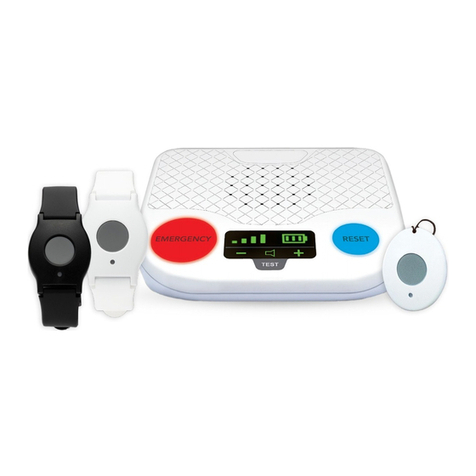
ADT
ADT Medical Alert Plus System Quick installation guide
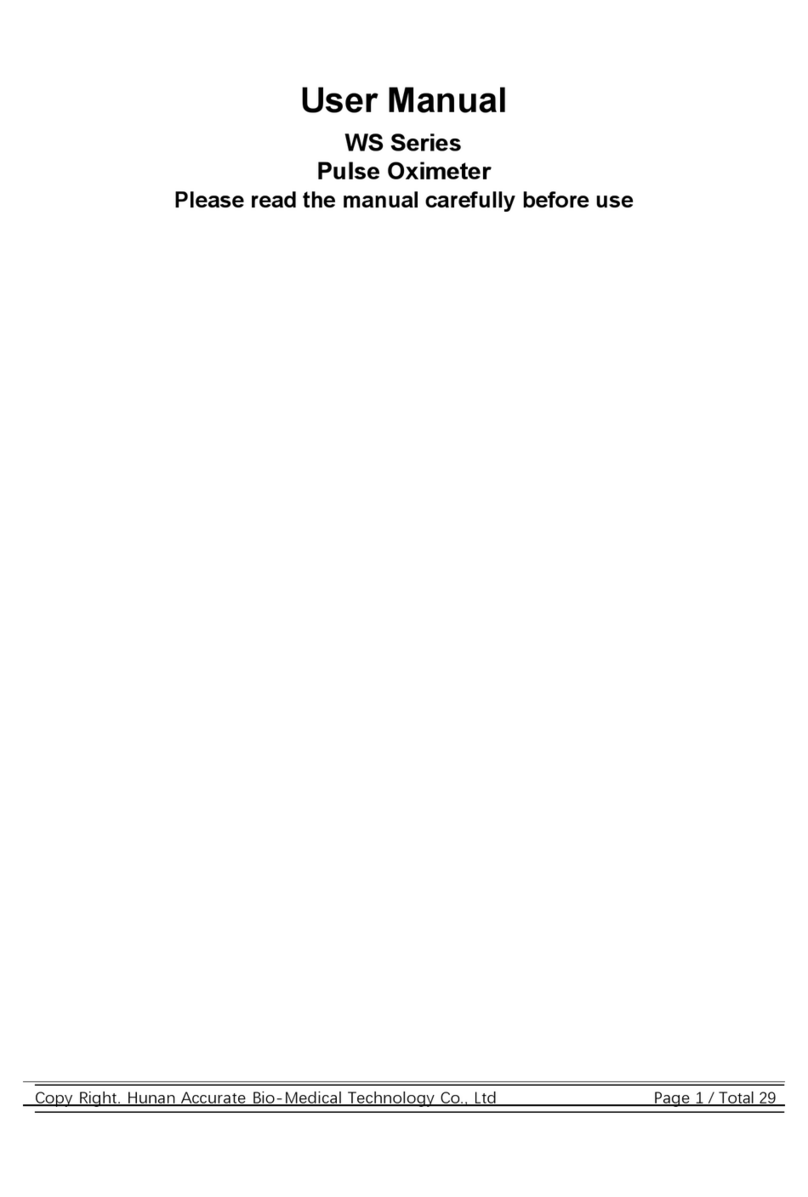
Accurate Bio-Medical Technology
Accurate Bio-Medical Technology WS Series user manual
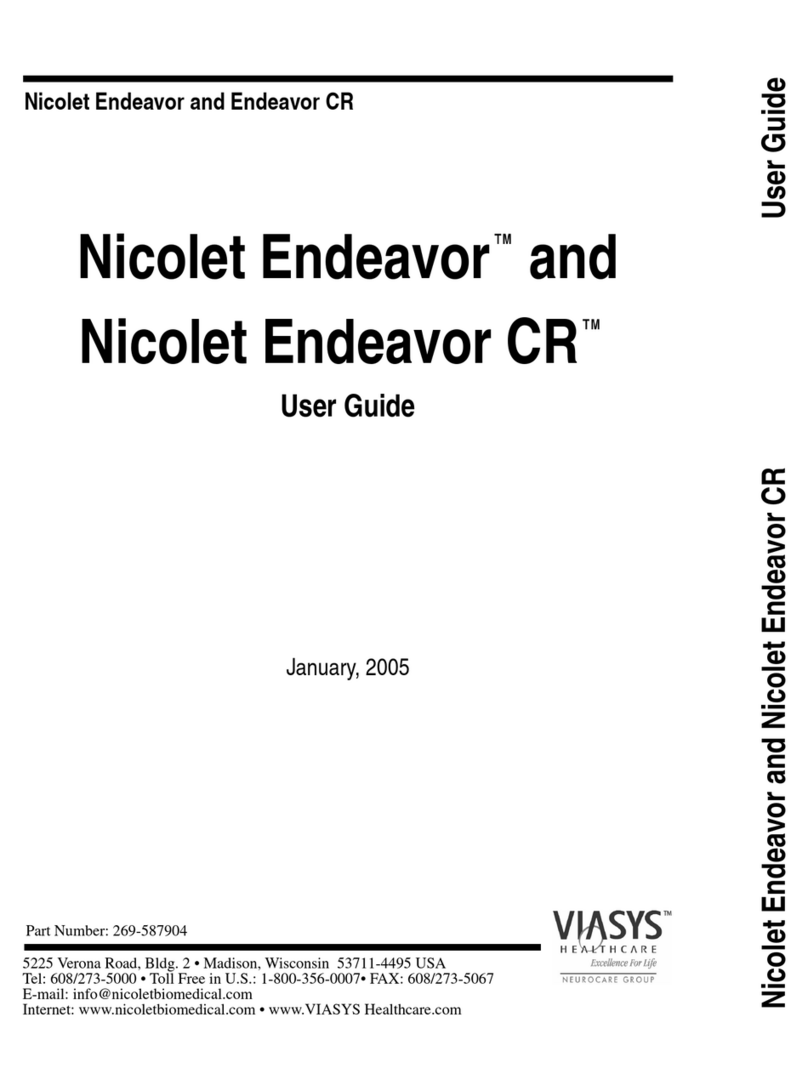
VIASYS
VIASYS Nicolet Endeavor user guide
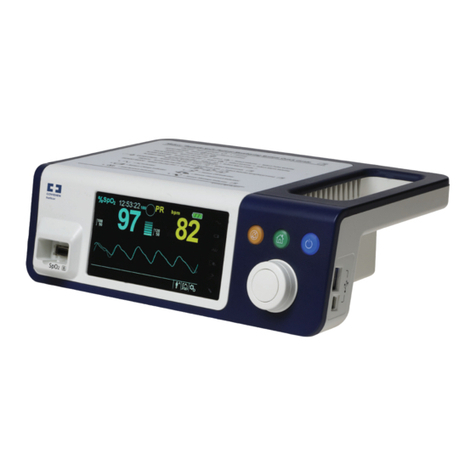
Covidien
Covidien Nellcor Operator's manual
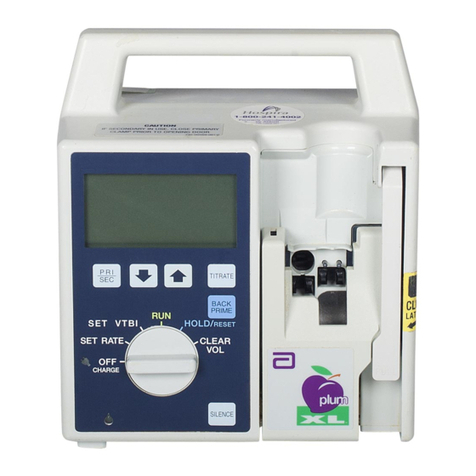
Hospira
Hospira Plum XL System Operating Manual
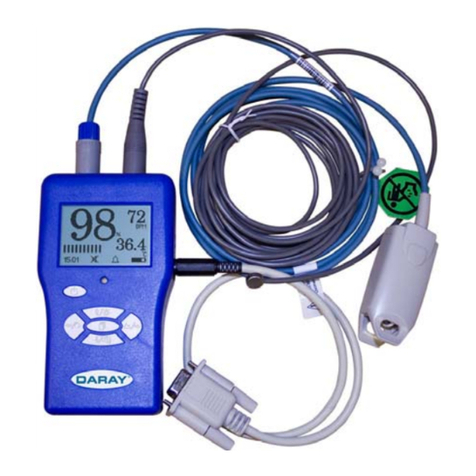
DARAY
DARAY V402+ operating manual
